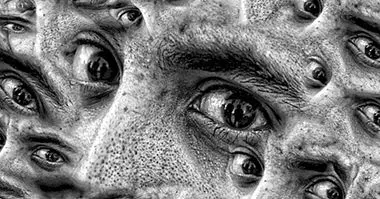Cultural syndromes: what they are, what symptoms they present, and 7 examples
Although most mental or psychopathological disorders occur with almost the same fire anywhere in the world, there are certain mental disorders that only occur in a specific society or culture. These are the so-called cultural syndromes .
Also known as cultural mental disorders, they are characterized as psychopathological pictures that are given specifically in the members of a culture , but that can become so habitual in certain places that where they appear they come to be considered alterations of the most common.
- Related article: "The 18 types of mental illnesses"
What are cultural syndromes?
Cultural syndromes are mental or psychosomatic disorders that affect only a specific community, society or culture. These syndromes are registered as diseases although, sometimes, there is no organic pathology in patients .
Although there may be similarities with other pathologies or experiences, cultural syndromes or disorders are not observed in other societies or cultural nuclei external to where it was discovered and localized.
Likewise, the term "cultural syndrome" itself has been much debated among the scientific community, and much of it is censured and refuses to use it, since they are categorized by their own culture.
Cultural syndromes place the differences between cultures at the center of attention. Differences that are needed especially in the different Aspects of spiritual, mental or physical perceptions and experiences . For example, a behavior or behavior that in another culture is experienced as abnormal or pathological in Western culture may be perfectly integrated into what is considered "normal."
- Maybe you're interested: "What is Cultural Psychology?"
How to identify a cultural syndrome?
There are certain distinctive features of cultural syndromes that make it possible to differentiate them. These characteristics are:
- The syndrome is defined and determined as a condition by the culture itself.
- That same culture is aware of the symptoms and knows the treatment .
- It is an unknown syndrome in other cultures.
- No organic origin has been found for this syndrome.
Within the symptomatology associated with these syndromes, both somatic symptoms, such as pain; or symptoms related to behavior disorders . Also, although some of these syndromes share a basic symptomatology, you can always find different elements related to the culture that can distinguish them.
Examples of cultural syndromes
Although there is a long registry of cultural syndromes, all of them categorized according to the region of the world of which they are their own, this article describes a series of cultural syndromes that stand out for being peculiar or striking .
1. Hwa-byung syndrome (Korea)
The Hwa-byung, also known as Hwa-byeong , is a Korean somatization disorder. This mental disorder appears in people who are unable to face or control their anger in situations they perceive as unfair.
The term is can be translated as a compound word formed by "fire" or "anger" and "disease". Also, if the geographical area is further restricted, in South Korea it is more commonly known as "depression or anger disease" .
The epidemiology of this disorder is of an incidence of 35% in the working population.
2. Sangue asleep (Cape Verde, Africa)
This alteration is culturally related to the islanders that inhabit Cape Verde, in Africa. This disorder includes the suffering of a wide range of neurological diseases , which include blindness, convulsions, numbness, pain, paralysis, stroke and tremors. It can also be responsible for an acute myocardial infarction, spontaneous abortion and infection.
The original term belongs to the Portuguese language and is translated literally as "sleeping blood".
3. Illness of the spirits (Indoamerica)
This disorder typical of Native American tribes is characterized by the fact that the person manifests a great variety of somatic and psychological symptoms associated with excessive symptoms, and on occasion, Obsessive concern over issues related to death .
4. Koro (China and Malaysia)
Koro disease is a disorder that affects mainly men, who experience a state of panic, with anxious tendencies, during which this he perceives that his penis diminishes in size or it is rolling back, as if it could disappear.
Although in a syndrome of the male sex, there have been cases in women, who perceived this shrinkage in their breasts and genitals.
Since states of anxiety can affect the volume and circumference of the penis, this panic is seen as feedback, leading to perform behaviors such as holding or fixing the penis with some type of instrument.
The majority of cases of Koro occur men, during the stage of adolescence and youth , who suffer from a sexual, paranoid or depressive disorder.
5. Scare or fright syndrome (Latin America)
A rather unusual or singular syndrome typical of Latin American culture is that of fright or fright. At the victim of a fright or shock experiences a series of symptoms associates that turn the mere act of scaring someone into the cause of an illness.
A great variety of symptoms associated with the scare syndrome have been described, some of them are:
- Loss of appetite
- Muscular weakness
- Lack of energy
- Pallor
- Vomiting and diarrhea
- Fever
- Unrest
- Depression
- Anxiety
- Fever
Cases have been recorded of people to whom this disease affected them to the point of causing their death.
6. Arctic hysteria or Piblokto (North Pole Populations)
This type of hysteria was registered in populations from the North Pole, such as Eskimos from Siberia, Canada, Greenland or Alaska .
This type of disorder can be divided into two different syndromes:
- A syndrome typical of the Siberian region whose main characteristic is that the person suffers a strong imitative mania .
- A state in which the person suffers a frenetic dissociation .
In either of the two varieties the person returns to his normal state once the crisis has passed.
7. Morgellons syndrome (Western Society)
In the Morgellons syndrome the person is invaded by a delirium according to which believes to be infected by infectious elements or capable of transmitting a disease , such as insects and parasites.
People suffering from this disorder manifest a series of skin lesions due to the obsession with scratching and biting the skin, as the patient feels a constant tingling in it.



















